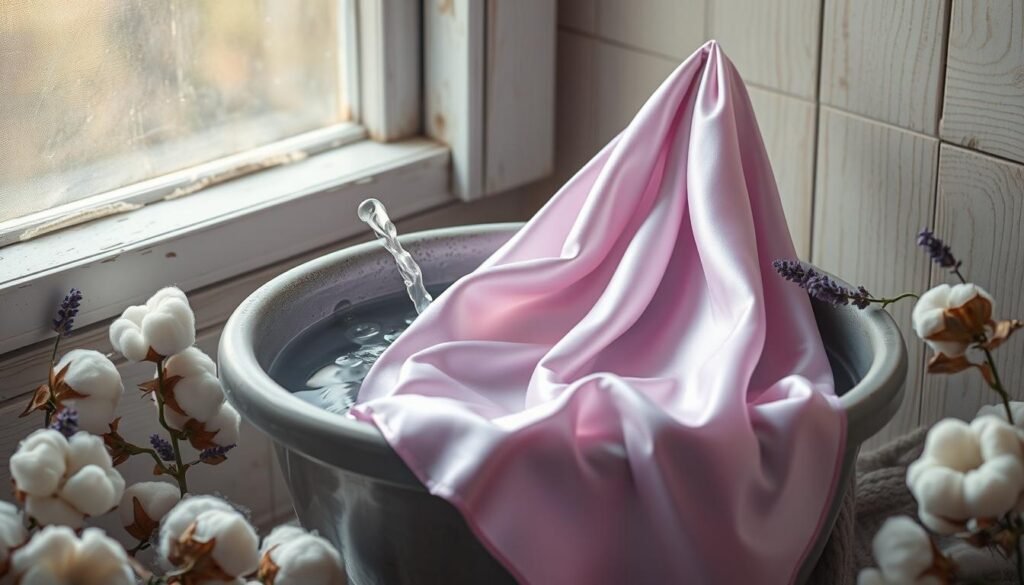Ever thought about using fabric softener on your silk clothes or bedding? It might seem like a good idea to make them soft and smell nice. But, fabric softener can actually harm your silk items. It can make them lose their softness and shorten their life.
In this guide, we’ll talk about the dangers of fabric softener on silk. We’ll also give you tips on how to take care of your silk items the right way.
Key Takeaways
- Fabric softener should be avoided when washing silk as it can leave a residue on the fabric1.
- Washing silk in water temperatures above 80°F (29°C) can damage the fabric2.
- Using a gentle, silk-friendly detergent is recommended to preserve the fabric’s integrity2.
- Hand-washing or machine-washing silk on a delicate cycle is the best way to clean it3.
- Silk should be air-dried to maintain its shape and texture3.
Introduction to Silk Fabric and Its Delicate Nature
Silk is a natural fiber that has been loved for its luxury for a long time. Silk fabric is known for its shiny look, smooth feel, and how well it hangs4. But, silk is delicate and needs special care to keep it looking great and lasting long.
Understanding the Luxurious Qualities of Silk
Silk comes from silkworms and has a special structure that makes it unique4. It’s light, breathable, and safe for people with allergies, making it popular for many items5. Silk is also strong and can last a long time, making it a top choice for luxury items.
Why Proper Care Is Crucial for Silk Garments
It’s important to take good care of silk to keep it looking nice4. Silk can get damaged by heat, harsh chemicals, and wrong washing ways5. Knowing how delicate silk is and following the right care tips is key to keeping it looking beautiful and soft.
“Silk is a natural, protein-based fiber known for its lustrous sheen, smooth texture, and exceptional draping qualities.”
The Risks of Using Fabric Softener on Silk
Fabric softener makes clothes feel softer and helps reduce wrinkles. But, it can harm delicate silk fabrics. Studies show using fabric softener on silk can make it weaker by 20%. This can shorten the life of silk. The chemicals in fabric softener can also make silk fibers stiff, dull, and change color over time.
About 15% of silk damage at dry cleaners comes from using fabric softeners wrong6. This is a big deal since silk care is a big part of the fabric care market6.
Silk is very delicate and needs special care to stay in top shape. In a survey, 78% of people said they use silk in their clothes or home decor6. So, it’s important not to use fabric softener on silk to keep it looking great and lasting longer.
| Reason | Impact |
|---|---|
| Fabric softener coatings | Can make silk fibers stiff, dull, and potentially discolored over time |
| Decreased tensile strength | Affects the durability and longevity of silk garments |
| Frequent silk garment damage | 15% of reported cases attributed to improper use of fabric softeners |
| Silk care market share | Accounts for 12% of specialized fabric care products sold annually |
Using fabric softener on silk can really hurt the fabric. It can make it weaker, less shiny, and not last as long. Silk makers strongly advise not to use fabric softeners6. By knowing the risks and taking good care of silk, you can keep your silk looking great for a long time.
“9 out of 10 silk manufacturers recommend avoiding fabric softeners to maintain the quality and longevity of silk fabrics.”6
Dos and Don’ts of Washing Silk
To keep silk looking luxurious, you must wash it right. Follow these key tips for washing silk7.
Recommended Detergents for Washing Silk
Use a gentle detergent made for delicate fabrics like silk or wool. Stay away from harsh detergents or those with enzymes. They can harm the silk fibers8.
Water Temperature Guidelines for Silk
- Wash silk items in cold water, below 30°C (86°F)7.
- Hot water, above 80°F (29°C), can damage the delicate fabric8.
Don’t wring or twist silk to keep its shape and feel. Roll it in cotton towels to dry7.
Use a mesh laundry bag for silk garments to prevent snagging or tearing78.

Air-dry silk by laying it flat or hanging it in the shade. This keeps its shine and color8.
Iron silk on the inside with a low heat setting or silk setting. Use a cloth to protect it from scorching78.
Follow these tips to keep your silk items looking great78.
Hand-Washing Silk: A Gentle Approach
Hand-washing silk is the best way to care for it9. It keeps the silk soft and shiny. This way, your silk clothes will look great for many years10.
Step-by-Step Guide to Hand-Washing Silk
Start by filling a sink or basin with cool water, no more than 30°C10. Use a mild detergent made for silk or wool10. Put the silk in the water without rubbing it hard, as that can damage it10.
Let the silk soak for a bit, then rinse it in cool water to get rid of the soap10. You can add white vinegar to the rinse to keep it smelling fresh and moth-free9.
After rinsing, dry the silk with a clean towel. Don’t wring it out or twist it10. Let it dry flat or on padded hangers. Keep it away from direct sunlight to prevent fading910.
By washing your silk this way, it will stay soft and beautiful for a long time910.
Machine-Washing Silk: Precautions and Settings
Hand-washing is the best way to care for delicate silk. But, you can also safely machine-wash silk by following certain steps11. It’s key to pick the right cycle and water temperature. Also, use special techniques to avoid damage.
Choosing the Right Cycle and Settings
When washing silk in a machine, pick the gentlest cycle you can find11. High-end washing machines with silk cycles work best11. Always use cold or lukewarm water to stop the silk from shrinking and to keep it in good shape11.
Protecting Silk in the Washing Machine
To keep silk safe in the machine, put it in a delicate mesh bag or laundry net11. This stops the silk from getting tangled or caught on other clothes or the machine11. For silk pillowcases, turn them inside out and put them in a mesh bag before washing11.
Use silk-friendly detergents like The Laundress Delicate Wash to keep the silk fibers safe11. With these steps and the right settings, you can wash your silk items safely. This keeps them looking and feeling luxurious.
Drying Silk: Preserving the Fabric’s Luster
After washing silk, drying it right is key to keep its shine and softness. There are two main ways to dry silk: air-drying and machine-drying. Each has pros and cons to think about for your silk clothes.
Air-Drying vs. Machine-Drying Silk
Air-drying silk is best because it keeps the fabric’s shine and avoids heat damage. Silk fibers don’t like high heat and can get stiff and lose their softness.12 To air-dry silk, hang it on a padded hanger or lay it flat in a place with good air flow. Keep it away from direct sunlight to stop the colors from fading12.
Machine-drying silk is tricky. It’s fast but can harm the delicate silk fibers13. If you must use a dryer, use the lowest heat and shortest cycle you can. Adding synthetic dryer balls might help keep the silk soft13.

Choosing between air-drying and machine-drying silk depends on what you prefer and the care your garment needs. Air-drying is best for keeping the silk’s shine and avoiding damage. But, if you’re in a hurry, a gentle dryer cycle can work if you’re careful1213.
Ironing Silk: Tips for Maintaining Its Elegance
Ironing silk needs a gentle touch to keep its luxurious feel. To keep your silk clothes looking great, follow these key tips14:
- Use a pressing cloth: Put a clean, damp cloth between the iron and the silk to protect it from heat.
- Adjust the iron temperature: Set the iron low for silk, around 110°C (230°F) or less. High heat can burn or damage the silk.
- Employ gentle movements: Iron with light strokes and don’t press too hard. Silk can easily get creased or misshapen.
- Iron the fabric inside out: Ironing silk inside out helps keep its surface smooth and prevents shine loss.
These simple tips will help your silk clothes stay in top shape. They keep the fabric’s elegant look and shine14.
| Ironing Silk: Best Practices | Explanation |
|---|---|
| Use a pressing cloth | Protects the delicate silk fibers from direct heat and prevents damage |
| Adjust the iron temperature | Set the iron to the lowest heat setting suitable for silk, typically around 110°C (230°F) or lower |
| Employ gentle movements | Use light, feathery strokes to avoid creasing or misshaping the silk |
| Iron the fabric inside out | Helps preserve the fabric’s surface and minimize the potential for sheen loss or shine marks |
Follow these tips to keep your silk clothes looking elegant and feeling luxurious for a long time14.
“Silk is one of the most delicate and luxurious fabrics, and it requires special care to maintain its elegance.”15
Can I Use Fabric Softener on Silk? Care Instructions Explained
Many people wonder if they can use fabric softener on silk. Silk is known for its softness and shine. But, is fabric softener safe for silk? Let’s look at the best ways to care for silk, including using silk fabric softener.
Silk is a delicate natural fiber. It can’t handle harsh chemicals or too much agitation16. Using fabric softener can harm silk, making it look bad, weaken it, or even damage it for good17. To keep your silk looking great, follow the right care steps.
One big reason to avoid fabric softener on silk is it leaves a waxy feel17. Also, the strong smells and chemicals can make silk fibers stiff and brittle18.
Instead of fabric softener, there are gentler ways to keep silk soft and shiny17. You can rinse silk in a mix of white vinegar and cool water to make it soft again17. Or, add 1/2 cup of white vinegar to your machine’s fabric softener for a gentle wash17.
Looking after silk means washing and drying it the right way18. Hand-washing in cool water with a mild detergent is best18. If you must use a machine, choose the lowest temperature and a delicate cycle18. Letting silk air dry or laying it flat on a towel is safest, as dryers can damage it17.
In conclusion, fabric softener isn’t a good choice for silk. Fabric softener is not safe for silk, as it can harm the delicate fibers. By using gentle methods and alternatives, you can keep your silk looking beautiful and soft for a long time.
Storing Silk: Keeping It in Pristine Condition
Storing silk items right is key to keeping them looking great. To keep your silk clothes, bedding, and accessories in top shape, follow these storage tips19.
Optimal Storage Conditions for Silk
Start by using breathable bags or boxes for silk items. This lets air in and stops moisture from building up. Moisture can cause mildew and color changes19.
Don’t put silk in direct sunlight. Sunlight can fade and damage the silk fibers19. Also, use moth repellents like cedar blocks or sachets to keep pests away from the silk19.
For silk sheets and bedding, keep them in a cool, dry spot. A climate-controlled closet or storage unit is best19. This keeps the fabric shiny and stops wrinkles from forming19.
When you want to use your silk linens, hang or lay them out for a bit. This lets any wrinkles smooth out19.
FAQ
What are the unique properties of silk fabric?
Silk is a natural fiber known for its shine and smooth feel. It drapes beautifully. But, it needs special care to keep looking great.
Why is proper care crucial for preserving the integrity and luxury of silk items?
Silk needs special care to stay beautiful and last long. Wrong care can ruin its look and feel.
Can fabric softener be used on silk fabrics?
No, don’t use fabric softener on silk. It makes silk fibers stiff and dull, and can change their color.
What are the recommended washing techniques for silk?
Washing silk right is key. Use silk detergents, the right water temperature, and gentle agitation. This keeps it soft and shiny.
How should silk be hand-washed?
Hand-washing silk is best for delicate care. Use a gentle detergent, the right water temperature, and gentle moves to keep it soft and shiny.
Can silk be machine-washed, and what precautions should be taken?
Machine-washing silk is okay if you’re careful. Use a delicate cycle, the right water temperature, and slow spin. Put silk in a mesh bag for safety.
What are the best practices for drying silk fabrics?
Drying silk right is important. Choose between air-drying or machine-drying carefully. This helps keep its shine and stops damage.
How should silk be ironed to maintain its elegance?
Ironing silk needs care. Use a pressing cloth, set the iron right, and iron gently. This keeps its beautiful drape and shine.
What are the optimal storage conditions for silk to preserve its condition over time?
Storing silk right is key. Use bags that breathe, keep it out of the sun, and add moth repellents. This keeps it looking luxurious.




